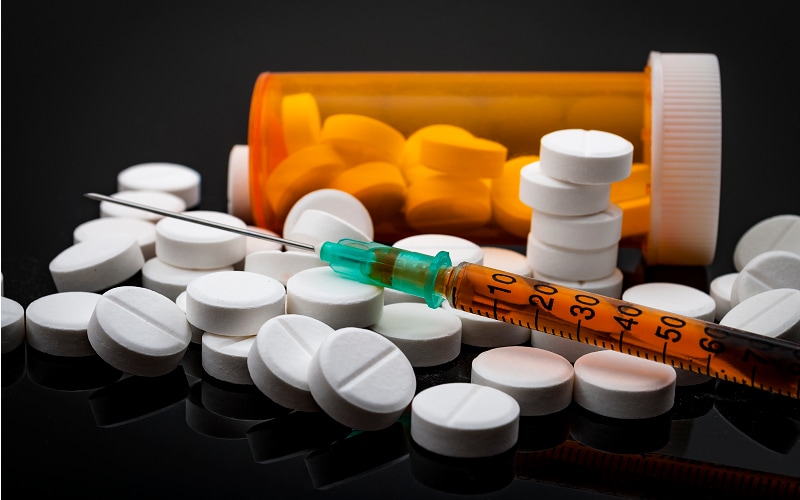Drug Use-associated Hospital Encounters Data From Selected Hospitals
The National Hospital Care Survey (NHCS) collects data on patient care in hospital-based settings to describe patterns of health care delivery and use in the United States. Settings include inpatient and emergency departments (EDs). From these data, NHCS contributes information on national public health threats such as the current opioid emergency. The 2020 – 2023 NHCS are not yet fully operational—as a result, data presented here are preliminary and not nationally representative.
Data are from Uniform Bill (UB)-04 administrative claims—25 hospitals submitting inpatient and 25 hospitals submitting ED claims—from January 1, 2020–May 27, 2023. Although not nationally representative, the data provide insight into hospital encounters involving the use of opioids and other drugs. NHCS data submitted from different types of hospitals (general acute and children’s hospitals, among others) provide information from indicators related to hospital encounters due to drug use, such as overall drug use, comorbidities, and drug and multidrug overdose. NHCS data can also be used to report on hospital encounters over time on a monthly basis.
Tabulated data show the percentage of encounters involving drug use, for all drugs and selected drugs over time. Data are presented for each setting (inpatient and ED) and calendar month, by age and sex.
Tabulated data show the percentage of encounters involving drug use for all drugs and selected drugs, by hospital urban–rural location. Hospital location is grouped into large central and fringe metropolitan area, medium and small metropolitan area, and rural area. Data are presented for each setting (inpatient and ED) and calendar month.
Tabulated data show the percentage of encounters involving drug use, for all drugs and selected drugs over time and for co-occurring disorders (defined as coexistence of a substance use disorder and a selected mental health issue) over time, among all inpatient or ED encounters in the reporting hospitals. Data are presented for each setting (inpatient and ED) and calendar month, by age and sex.
Tabulated data show the percentage of encounters involving drug use and a COVID-19 diagnosis, for all drugs and selected drugs over time, among all inpatient or ED encounters in the reporting hospitals. Data are presented for each setting (inpatient and ED) and calendar month, by age and sex.
Tabulated data show the percentage of drug overdose encounters for all drugs and selected drugs over time, among all inpatient or ED encounters in the reporting hospitals. Data are presented for each setting (inpatient and ED) and calendar month, by age and sex.
Tabulated data show the percentage of encounters involving opioid overdose and concurrent overdose of stimulants, cannabis, and benzodiazepines over time, among all inpatient or ED encounters in the reporting hospitals. Data are presented for each setting (inpatient and ED) and calendar month, by age and sex.
The Figure shows the number of inpatient and ED hospital visits for the 25 hospitals that submitted inpatient data and the 25 hospitals that submitted ED data from January 1, 2020–May 27, 2023.
- 3,841,977 ED encounters and 1,393,978 inpatient discharges.
Technical Notes
- Data are not nationally representative.
- Less than 1% of all encounters are excluded due to missing sex, age, or diagnosis.
Data provided are from small and large hospitals across the country in urban and rural locations. Information on characteristics of the hospitals that provided UB–04 administrative claims data follow.
Data used in figures are preliminary and have not undergone final edits. The data presented will be updated every 2 months to include data for the remaining months in each calendar year. Results may change in monthly updates and with the release of final NHCS data files.
Percentages of general acute and children’s hospitals included in this summary are higher compared with percentages in the NHCS hospital frame file. No psychiatric hospitals or rehabilitation/long-term acute hospitals are eligible for reporting in this summary. Additionally, the percentage of hospitals with 500 or more beds, in the Northeast, and in urban areas included in these results are greater than those in the NHCS hospital frame file.
| 2020 – 2023 NHCS reporting eligible hospitals | 2020 NHCS frame | ||
|---|---|---|---|
| Type of service | General acute care | 88.0 | 71.3 |
| Children’s | 12.0 | 2.9 | |
| Psychiatric | 0.0 | 13.0 | |
| Rehabilitation or long term acute | 0.0 | 12.5 | |
| Bed size | Less than 100 | 12.0 | 57.4 |
| 100 to 299 | 32.0 | 29.7 | |
| 300 to 499 | 20.0 | 9.3 | |
| 500 or more | 36.0 | 3.6 | |
| Region | Northeast | 36.0 | 13.6 |
| South | 16.0 | 40.7 | |
| Midwest | 32.0 | 26.9 | |
| West | 16.0 | 18.8 | |
| Urban-rural status | Metropolitan statistical area (MSA) with a population of 1 million or more people | 48.0 | 39.5 |
| MSA with a population less than 1 million people | 36.0 | 31.5 | |
| Micropolitan (urban clusters with a population of at least 10,000 but less than 50,000) and noncore (most rural) areas | 16.0 | 29.0 | |
NOTE: The 2020 NHCS frame has 25 reporting hospitals and 6,906 total hospitals.
SOURCE: National Center for Health Statistics, National Hospital Care Survey, 2020–2023.
NHCS is designed to collect electronic data from UB–04 administrative claims or electronic health records for all encounters in a calendar year. From 2020-2022, the NHCS nationally representative sample included 608 hospitals. In 2023, the NHCS sample was 601 hospitals. Eligible hospitals from the 50 states and District of Columbia include noninstitutional and nonfederal hospitals with six or more staffed inpatient beds. Information collected includes diagnoses, procedures, demographics, discharge status, and patient identifiers such as name and Social Security number. Hospitals are currently being received into the survey.
Data are provided on hospital care and utilization for drug use for a nonrandom subset of NHCS hospitals, including the occurrence of hospital encounters involving drug use over time, the presence of drug use with co-occurring disorders, the presence of drug use with COVID-19, and the occurrence of drug overdose and multidrug overdose. The figures and tables presented represent different groups depending on the measure of interest.
For more details on NHCS, visit: https://www.cdc.gov/nchs/nhcs/index.htm.





